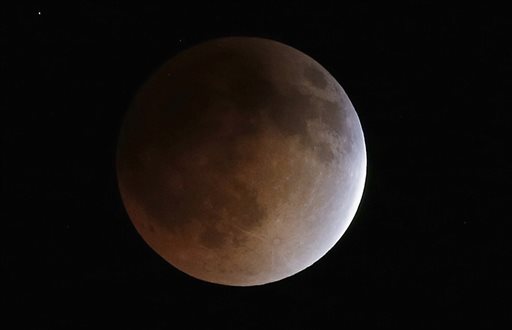Crimson glory: All you need to know about the rare blood moon

The moon turns an orange hue during a total lunar eclipse in the sky above Phoenix in this April 15 file photo. AP
SINGAPORE—Across the world on Wednesday, sky-watchers will be casting their gaze towards the heavens for a glimpse of the rare blood moon — where the moon appears reddish as a result of a total lunar eclipse.
This phenomenal cosmic event begins Wednesday before sunrise in North America, and is a cause for excitement among astronomy enthusiasts all over the world.
Here are some interesting facts about this once-in-a-red-moon occurrence:
What is a blood moon?
When the Sun, Earth and Moon are aligned, a total lunar eclipse occurs and sees the Moon passing close to the centre of the Earth’s inner shadow – the umbra. The filtering and refracting effect of Earth’s atmosphere creates a blush on the face of the Moon, giving it a reddish hue.
Why is it significant?
Not only is this eclipse one of the most striking astronomical events visible from Earth, the blood moon can also be seen by the naked eye and does not require telescopes.
What’s the difference between lunar and solar eclipses?
For a solar eclipse to occur, the Moon must come between the Earth and Sun; for a lunar eclipse to happen, the Earth must come between the Sun and Moon.
In all instances, all three bodies must be nearly in a straight line.
In total solar eclipses, the Sun is darkened save for some wisps of light around its corona – as though a hairy sackcloth was held up in front of it. It is also termed a “sackcloth sun”.
In total lunar eclipses, the Moon is not completely darkened. Depending on the weather, the Earth’s atmosphere filters out blue rays, and what results is the Moon looking faintly dull orange or red. Hence the term, “blood moon”.
What are some noteworthy lunar eclipse dates?
The longest blood moon took place on July 23, 1888, and lasted one hour and 46 minutes.
The year 2011 marked the longest total lunar eclipse in a decade, lasting one hour and 35 minutes.
The shortest one is projected to occur on Nov 9, 2068, and is estimated to last just 18 minutes.
How often does a blood moon tetrad happen?
Blood moons are rare occurrences, and tonight’s one is even more so because it is one in a set of four eclipses – what astronomers call a tetrad.
Tetrads are so uncommon, that there was reportedly no tetrad for 300 years, between 1600 and 1900.
Tonight’s blood moon is said to be the second in a series that will happen over two years, with the first having taken place earlier this year in April. The third is slated for April 4, 2015, and the fourth on Sept 28, 2015.
The next tetrad is predicted for 2032-2033.
Interestingly, the ongoing 2014-2015 tetrad falls in the Hebrew year 5775 – which runs from September 2014 through September 2015 – and will supposedly fall exactly on four major Hebrew festivals.
Where and what time can it be seen?
Tonight’s celestial show can be watched by sky-gazers in the Americas and Asia.
The full eclipse will begin at 3.25am Pacific Daylight Time (6.25pm Singapore time) and will continue for about an hour.
Recent blood moon occurrences in Singapore
In 2007, Singapore caught only the tail end of a blood moon, although people from places such as the United States, South America and Australia witnessed it in its full glory.
In 2011, some 700 people gathered at the Singapore Science Centre to watch the eclipse, but overcast skies resulted in a failed sighting.
In April 2014, the first eclipse in the current 2014-2015 tetrad took place, but it was not visible in Singapore. Although the moon during this eclipse had an unusual tinge, this was said to be attributed to atmospheric effects, dust or particles.
Where to view the blood moon in Singapore?
The Astronomical Society of Singapore (Tasos) has organised an observation gathering tonight for the rare total lunar eclipse at Labrador Park, near the Tanjong Berlayer Beacon facing Sentosa.
The start of tonight’s total lunar eclipse phase is estimated to be at 6.25pm, and since Singapore’s moonrise is estimated to be at 6.52pm tonight, the moon is expected to be in total eclipse phase from the time of its rising.
How else can we view it?
Watch a live stream of tonight’s blood moon by Slooh, a company that connects telescopes with the Internet to provide access to the broader public.
Alternatively, US space agency Nasa is also providing a live feed to the event tonight.














